|
|
 |
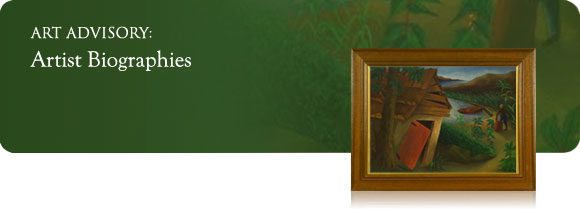
Alphabetical
A | B | C | D | E | F | G | H | I | J | K | L | M | N | O | P | Q | R | S | T | U | V | W | X | Y | Z
Daeni, Pino
Dali, Salvador
Dardari, Alfano Alfredo
Daumier, Honore
David, Jean
Davies, Arthur Bowen
Davies, Kenneth Southworth
de Barros, Andre Martins
De Garcia Paredes, Vincente
De Haas, Mauritz Frederik Hendrick
|
de Hoog, Bernard
Delarue, Lucien
De La Vega, James
Delaunay, Sonia
Deveau, Jacques
de Vlaminck, Maurice
Dubuffet, Jean
Dufy, Jean
Durer, Albrecht
|
|
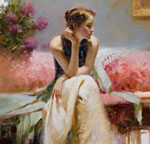
Pino Daeni
1939-2010
Italian, New Jersey/New York affiliated illustrator and painter
Pino Daeni was an Italian Impressionist book illustrator and artist, born under the name Giuseppe D’Angelico Pino. He is known for his unique style of feminine, romantic women and strong men painted with his loose but accurate brushwork. Considered one of the highest paid book illustrators of his time, he created over 3,000 book covers, movie posters and magazine illustrations.
|
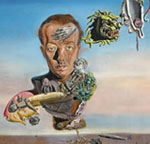
Salvador Dalí
1904-1989
Spanish surrealist painter
Salvador Dalí was born on May 11, 1904 in Figueres, Spain. He was a skilled draftsman, best known for the bizarre images in his surrealist work. Dalí had his first public exhibition at the Municipal Theater in his hometown in 1919. In 1922, he began his studies at the Real Academia de Bellas Ares de San Fernando in Madrid. Dalí had met both Joan Miró and Pablo Picasso, and as he developed his own style, his works were heavily influenced by both artists, but he was also influenced by many classical artists such as Raphael, Vermeer, and Velazquez.
By 1930, Dalí had been working with other surrealist artists for a few years, and his style began to take shape. The following year, Dalí created his most famous work, The Persistence of Memory. In 1934 he had his first exhibition in New York and was introduced to the American art world, creating an immediate sensation. In 1938, he met Sigmund Freud, with whom he shared many intellectual ideas about the unconscious mind. In his later years, Dalí’s health declined. There have been allegations that he was forced by his guardians to sign blank canvases that would later be sold as originals. As a result of this, many art dealers are wary of late works attributed to Dalí. On January 23, 1989, he died of heart failure his is hometown, where he is buried.
|
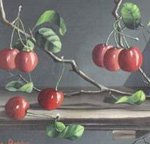
Alfano Alfredo Dardari
1924-1988
Italian surrealist painter
Alfano Alfredo Dardari was a surrealistic painter born in Meldola Italy in 1924. He painted in the trompe-l’oeil technique and his work has been described as “metaphysical hyper realism.” His works tend to depict still-lifes of roses, cigarettes, and wooden matchsticks, but he also painted clowns. Dardari exhibited in Italy and in the U.S., and in 1979, he received the Golden Brush Award. He died in 1988.
|
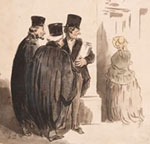
Honore Daumier
1808-1879
Honore Daumier was born in Marseilles, France on February 26, 1808. At the age of twelve he sketched everything he saw and finally started studying art with an academician whose idea of instruction was to have his pupils copy plaster casts hour after hour. A year later, he enrolled in the Academy Suisse, an informal school where students could draw from the model in the mornings and still hold down jobs. Daumier was one of the greatest draftsman who ever lived.
The lithograph was a comparatively new art in those days, but it quickly became Daumier's bread and butter. He began turning out political cartoons for an ardently antiroyalist magazine called La Caricature. Daumier turned out lithographs of arrogant aristocrats, greedy landlords, sour-faced men and nagging wives, sinister lawyers and pompous judges.
Daumier made lithographs, 3958 in all, until he went blind at sixty-five. But all along he was painting, though no more than a handful of his canvases were shown in public before the last year of his life. He was a draftsman whose brush drew spare and strong, and whose preoccupation was people. His graphic works are unsurpassed for clarity, expressiveness, truth to type and nervously rhythmic life. He became blind in 1877, then died suddenly in 1879 at the age of 70 of a stroke at Valmondois (Seine-et-Oise) in a house given him by Corot, the landscape painter.
|
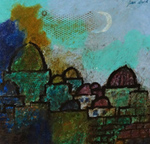
Jean David
1908-1993
Israeli modernist genre, portrait, and cityscape painter and illustrator
Jean David was a painter and designer, known for his contributions to the Romanian avant-garde and to the early modernist art of Israel. He studied from 1927-1937 at various art academies in Paris. In 1929, he participated for the first time at a collective exhibition in Bucharest, and in 1933 he had his first solo exhibition. In the early 1930’s, David was a member of the Surrealist group “unu” (meaning “one”). In 1942, he left Romania in a boat with twelve other Jews. After being captured by British authorities in Cyprus, he managed to reach Palestina in 1944. Together with Marcel Janco, he founded the first artist village in Israel, known as Ein Hod. David also received recognition for his poster designs and other works for the El Al air company.
|
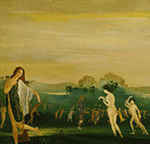
Arthur Bowen Davies
Arthur Bowen Davies
American Modernist
Arthur Bowen Davies was born in Utica, New York in 1862. He attended the Chicago Academy of Design from 1879 to 1882 and traveled to the West, including Colorado and Mexico City, where he worked as a drafting civil engineer. He briefly attended the Chicago Art Institute and in 1885 moved to New York City, where he studied at the Art Students League and Gotham Art Students League. While living in New York, he was able to support himself as a billboard painter, engineering draftsman, and magazine illustrator. In 1893, Davies made the first of many trips to Europe, in particular to study the Dutch realist painters. He later settled in Congers, New York and traveled extensively throughout the United States. Davies gained a reputation for ethereal figure paintings, expressing lightness and mysticism. He stylistically combined Symbolism, Tonalism, Art Nouveau, and Cubism across the mediums of painting and printmaking. Davies produced over two hundred graphic works between 1916 and his death in Italy in 1928. He is remembered for his work as the principal organizer of the 1913 Armory Show that revolutionized American art by introducing modernism to the public. As such, the Metropolitan Museum of Art held a memorial exhibition two years after his death. His work is represented in over 100 museums in America and Europe.
|
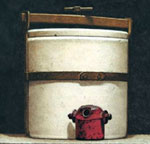
Kenneth Southworth Davies
b. 1925
American Realist Painter
Born in New Bedford, MA, Davies became a noted still life painter and long-time art teacher in CT. He attended the Massachusetts School of Art in Boston, and, after two years in the Army, studied at the Yale School of Fine Arts, graduating with a B.F.A in 1950.
|
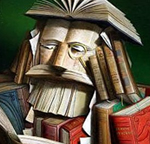
Andre Martins de Barros
b. 1942
Spanish Surrealist Artist
Andre Martins de Barros was born in 1942 in Pau, a small town in the French foothills of the Pyrenees, near the Spanish border. After completing his military service at the age of fifteen, he began to paint. A self-taught artist he has experimented with different styles, starting with classicism, to expressionism, to abstract, and eventually returning to the classic style which currently motivates him. Andre was particularly influenced by Rembrandt and Breughel, as well as other Renaissance artists. He now works in a studio in Montmartre, Paris. Each work is painstakingly created over many weeks, sometimes months, and a meticulous attention to detail and fine brushwork is evident.
|
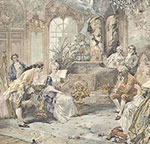
Vincente De Garcia Paredes
1845-1903
Spanish interior genre painter
The Spanish painter Vicente de Paredes is known for French 18th Century-style interior genre paintings depicting nobility.
|

Mauritz Frederik Hendrick De Haas
1832-1895
Dutch marine, landscape, and genre artist
One of the most famous 19th-century marine and landscape painters, especially of Long Island, Mauritz De Haas was born in Rotterdam, Holland where he studied at the Academy of Fine Arts. He also studied at The Hague, a pupil of Louis Meyer, and then specialized in watercolor in London. In 1859, at the age of twenty-seven he immigrated to the United States and set up a studio in New York. In his adopted homeland, he first became known for his European views and then for his scenes painted along the Northeast Coast. Among the latter were views of Long Island: Orient, Montauk, Peconic, Westhampton, Bridgehampton, and Southampton, as well as points along the Long Island Sound. He painted Civil War naval scenes for Admiral Farragut. A brother, William Frederick De Haas, was also a distinguished artist. De Haas felt a special affinity for Long Island because it resembled his native Holland in its terrain and ever-changing effects of light and atmosphere. He was determined to capture the full range of these effects, from bright sunshine reflected on the rippling waves of Long Island Sound to the cool moonlight shining on the beach at Southampton. According to one contemporary critic, he succeeded: "His pencil is equal facile whether portraying a storm on the coast, moonlight effects at sea, or brilliancy of the sunset hour." In painting moonlight scenes, the same source claimed, de Haas had "few equals."
Source: Fineoldart.com
|
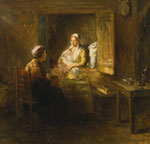
Bernard de Hoog
1867-1943
Dutch genre painter
Bernard de Hoog was a genre portrait artist working at the turn of the century. He was born in Amsterdam, Holland and studied under J.F Hulk and J.C van Essen at the Quellinus school in Amsterdam. His Popular scenes were exhibited and sold at many provincial and National galleries. He produced many of the most endearing images of interior scenes, looking back at life during the late eighteenth and early nineteenth centuries De Hoog followed the Hague School, primarily a movement of realism, a reaction against the previous mood of romanticism. He was advocating the simple country life, a happy and innocent atmosphere where children play a major part.
|
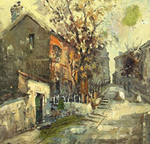
Lucien Delarue
1925-2011
French cityscape and still life painter
Lucien Delarue was born in Paris in November of 1925. He studied at the studios of Grande Chaumiere, Paris and was a pupil of Maitre Yves Brayer. He is known for his Impressionist depictions of the streets of Paris, floral still life paintings, country cottages, harbor views, and river scenes. In 1973, Delarue won the gold medal at the Salon of Clichy, a year later won the silver metal at the Salon des Artistes Francais, and the bronze medal at the Arts-Sciences-Lettres exhibition in Paris. His works were exhibited throughout France, as well as galleries in New York City and San Francisco. Delarue died in 2011.
|
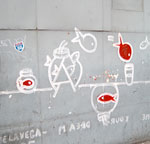
James De La Vega
b. 1968
American muralist and graffiti artist
James De La Vega was born in 1968 in East Harlem, New York, NY he is best know for his murals/graffiti art which feature aspirational sayings. He attended Cornell University and was awarded a BFA from the school in 1994. He is notable for being charged with misdemeanor graffiti charges after painting on the side of a Bronx warehouse in 2003, he was later convicted. In 2010 he closed his gallery in the East Village neighborhood of New York City. Recently De La Vega collaborated with the designer Tory Burch on a capsule collection.
|
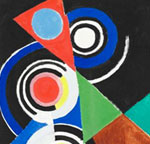
Sonia Delaunay
1885-1979
Jewish-French Orphist artist
Sonia Delaunay, married to artist Robert Delaunay, cofounded the Orphism art movement, noted for its use of strong colors and geometric shapes. Her work extends to painting, textile design and stage set design. She was the first living female artist to have a retrospective exhibition at the Louvre in 1964, and in 1975 she was names an officer of the French Legion of Honor. Her work in modern design included the concepts of geometric abstraction, the integration of furniture, fabrics, wall coverings, and clothing.
|
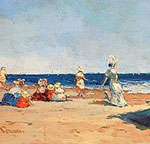
Jacques Deveau
b. 1937
French landscape painter
Jacques Deveau is a French contemporary painter working in the Impressionist style. His works often depict beautiful ladies and children. His rich, impasto technique and use of light and color capture scenes of tranquil beauty and the joy of life. Known for his beach scenes and landscapes, Deveau’s work has been represented by many prominent galleries appear in private collections throughout the world.
|
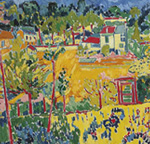
Maurice de Vlaminck
1876-1958
French Fauve landscape painter
Raised by musicians and growing up as a cyclist with a dream to become a professional, Maurice de Vlaminck became one of principal figures in the Fauve movement, together with Andre Derain and Henri Matisse. The Fauves were a group of modern artists who between the years 1904-1908 were united by their use of intense color. In 1893, he took drawing lessons and painted on the Ile-de-Chatou. As a child, he had learned violin from his father, and, in order to support his own family, he taught violin lessons and raced professionally until he contracted typhoid fever in 1896 and was forced to end his cycling career. That November, he began his military service and on June 18, 1900 he met Andre Derain. The pair eventually rented a studio together on the Ile-de-Chatou. Although he now focused mostly on his painting career, he continued to teach violin lessons for income. The two painted in the Fauvist style with intense coloration and brushstrokes. Eventually in the mid-1920’s Cubism took over Fauvism and de Vlaminck blamed Picasso. He died in 1958.
|
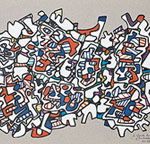
Jean Dubuffet
1901-1985
French painter and sculptor
Jean Dubuffet was born in Le Havre in 1901 to a wealthy family of wine merchants. He moved to Paris in 1918 to study painting at the Académie Julian where he became friends with artists Juan Gris, André Masson, and Fernand Leger. Dubuffet switched back and forth between creating art and selling wine until he finally devoted himself to art in 1942, when he began to paint figures of nude women in an impersonal and primitive way with the use of strong and unbroken colors, choosing subjects from everyday life. He had his first solo show in 1944. A year later he was influenced by Jean Fautrier’s paintings and began to mix sand and gravel into thick oil paint, painting his portraits in a manner that was deliberately anti-psychological and anti-personal. Dubuffet coined the term ‘art brut’ for art that was produced by non-professionals working outside of aesthetic norms, such as art by psychiatric patients, prisoners, and children. Dubuffet continued to collect these works and to create his own works in this manner until his death in 1985.
|
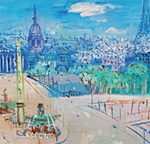
Jean Dufy
1888-1964
French Abstract Expressionist painter
Brother to the famous Raoul Dufy (1877-1953), Jean Dufy showed artistic talents from an early age. He became a student in Le Havre at the Ecole des Beaux Arts, with his brother as one of his teachers. When Raoul moved to Paris, Jean left the Ecole and followed him. For the next two years, he became associated with Cubist painters Picasso and Georges Braque. By 1914, he was exhibiting his early watercolors, which used muted tones and Cezanne’s hatching technique, at the Berthe Weill Gallery. That same year, he was drafted for military service and was stationed throughout France, where he painted many landscape scenes. In 1916, Jean worked in a studio with his brother, doing textile painting. He then began what would become a major component of his career for the next 30 years, porcelain decoration for Haviland in Limoges, France. Dufy was also very involved in painting sets for the theatres in France. By 1920, he was a member of the Salon d’Automne. Jean Dufy died in May of 1964 in France.
|
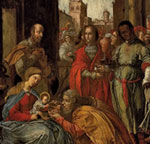
Albrecht Durer
1471-1528
Albrecht Durer was born in Nuremberg, Germany on May 21, 1471.Aat the age of fifteen, Durer was apprenticed to a painter.Durer was one of the greatest artists in German history. By adopting the new forms of the Italian quattrocento and connecting them to the already robust tradition of the German print, he almost single-handedly provoked the Northern Renaissance. For all-around inquisitiveness, he was surpassed only by his older contemporary, Leonardo da Vinci. Durer started traveling in 1490; he was not quite nineteen. He had spent four years apprenticed to a master painter and engraver, Michael Wolgemut. His restless wanderings across Europe included two trips to Venice and were capped by a year-long sojourn in The Netherlands, where he was a celebrity among celebrities, moving in a nimbus of fame through a circle that included Erasmus himself.
What fascinated Durer was Italian humanism and all that flowed from the discovery of classical antiquity. But in fact, the trips to Venice did not radically change his style. He became one of the first to sign and date even his most incidental drawings. He died in Nuremberg on April 6, 1528.
|
| |
|
| |
|
|


